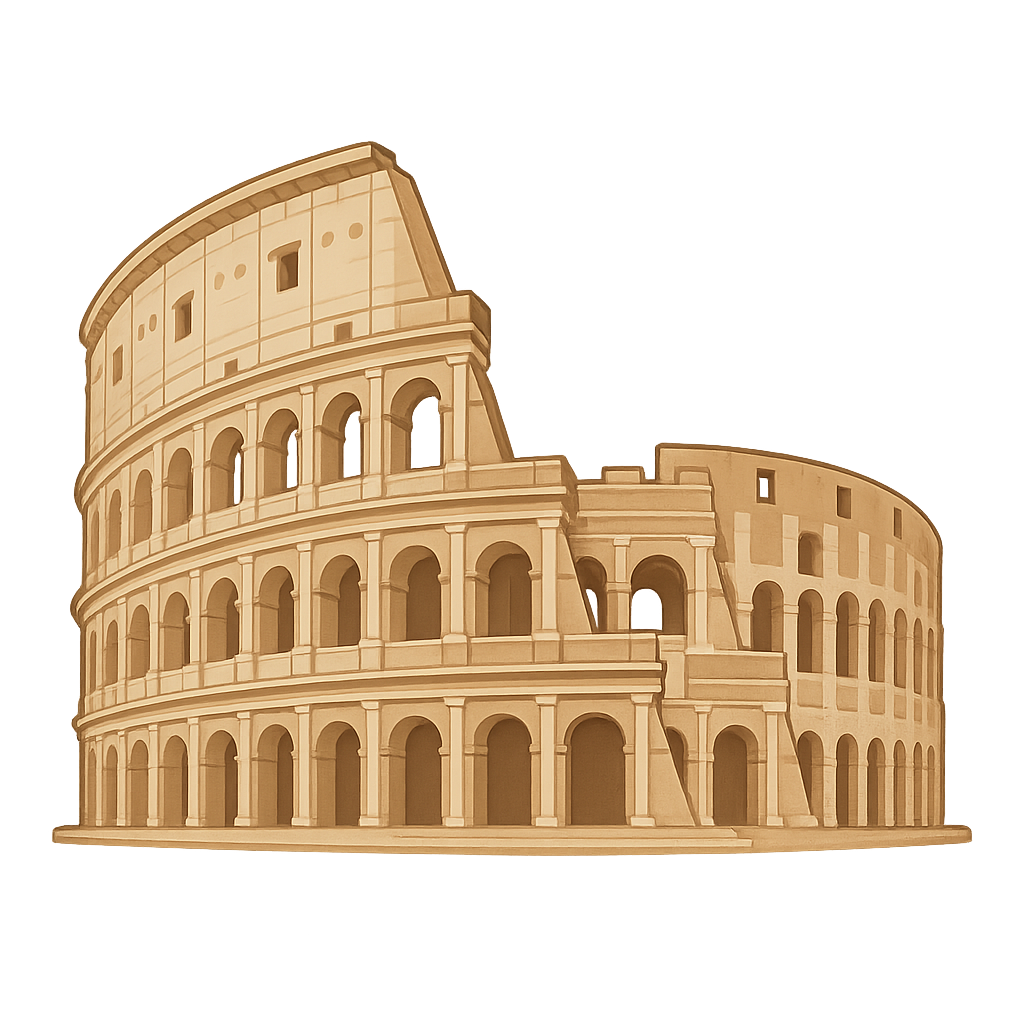The Stone Giant of Rome
I stand in the heart of a bustling city, a silent giant of stone and memory. The warm Italian sun has been my companion for nearly two thousand years, casting long shadows through my eighty archways as the world changes around me. From within my broken walls, you can hear the hum of modern traffic, but if you listen closely, truly listen, you might hear something else. You might hear the faint echo of a roaring crowd, the clang of ancient metal, and the whispers of history carried on the breeze. I am a great oval, a stone crown set upon the earth, with tiers of seating that once held a city’s worth of people. Today, millions of visitors from every corner of the globe walk across my arena floor, their footsteps tracing paths where history was made. They gaze up at my towering skeleton, imagining the vibrant life that once filled me. They see the scars left by time, earthquakes, and the hands of people who dismantled me for my stone, yet they also see strength. They see a monument that has refused to disappear, a testament to an empire that shaped the world. I am an amphitheater, a stage, and a survivor. I am the Colosseum.
My story begins with a grand idea, a gift to the people of Rome. Before I existed, this land was part of the extravagant Golden House of the Emperor Nero, a place of private luxury. But after a period of civil war, a new emperor named Vespasian came to power in 69 CE. He wanted to return this land to the public and give them something spectacular to unite them. His vision was for the largest amphitheater the world had ever seen. Construction began around 72 CE, a massive undertaking that showcased the brilliance of Roman engineering. An entire lake had to be drained to prepare my foundations. My outer walls were built from gleaming travertine stone, held together not with mortar, but with 300 tons of iron clamps. For my interior, the Romans used their revolutionary invention: concrete. This allowed them to create the complex network of vaults and corridors that supported my seating. Vespasian did not live to see me completed, but his son Titus proudly inaugurated me in the year 80 CE. He celebrated my opening with 100 days of magnificent games, a spectacle of immense proportions. A few years later, his brother, Emperor Domitian, made his own additions. He built the hypogeum, an incredible two-level subterranean network of tunnels, cages, and elevators directly beneath my arena floor. This underground labyrinth allowed animals and gladiators to appear as if by magic in the center of the action, adding to the drama that unfolded within my walls.
The roar of the crowd was the heartbeat of my existence for over four centuries. Imagine 50,000 spectators, from senators in the front rows to common people at the very top, all gathered under a colossal retractable awning called the velarium. This massive canvas sheet, operated by hundreds of sailors, protected the audience from the scorching Roman sun. The events I hosted were unlike anything seen before or since. There were the famous gladiatorial contests, where highly trained and disciplined athletes, celebrated like sports heroes today, displayed their skill and courage. Another popular spectacle was the venationes, or wild animal hunts. These events demonstrated the vast reach of the Roman Empire, as exotic creatures like lions, elephants, and crocodiles were brought from distant lands to be showcased. But perhaps my most breathtaking feat was the naumachiae, or mock sea battles. My creators had designed a complex system of aqueducts and drains that allowed them to flood the entire arena floor with water in a matter of hours. Full-sized ships would then float upon this man-made lake, reenacting famous naval victories for the cheering crowds. I was more than a building; I was the center of entertainment, a place where the power and ingenuity of Rome were put on full display for all to see.
Like all empires, Rome’s power eventually faded, and my role in the world changed with it. The last gladiatorial games were held in the 5th century CE, and soon after, my grand spectacles ceased forever. The centuries that followed were not always kind. Powerful earthquakes in 847 and 1349 CE caused large sections of my southern side to collapse, leaving me with the distinctive broken silhouette I have today. For a time, I was used as a quarry, and my strong travertine stones were taken to build palaces, churches, and bridges across Rome. I became a ruin, a skeleton of my former self. But even in my brokenness, I never lost my grandeur. Today, I am no longer a stage for games but a classroom for the world. I stand as a powerful symbol of Roman history and architectural genius. Millions visit me each year to walk through my arches, to feel the weight of history, and to be inspired by the enduring power of human creativity. I am a reminder that even when things fall apart, their spirit and their story can live on forever.
Reading Comprehension Questions
Click to see answer
